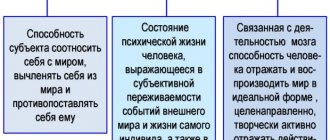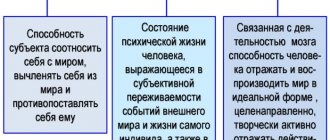Causes and consequences of conflicts
One of the important indicators of the socio-psychological climate in a team is conflict situations.
Conflict is one of the most common forms of organizational interaction, and indeed of all other relationships. It is estimated that about 15% of working time is spent on conflicts and their experiences.
Managers spend even more time resolving and managing conflicts.
Organizational conflict is one of the typical manifestations of conflict, that is, conflict as a sociological phenomenon that exists at different levels of social life: in relations between individuals in primary groups, for example, in families, within large and small organizations, between organizations, including states and the like. That is why the general theory of conflict and, above all, the theory of social conflicts are applicable to the understanding of organizational conflict. Social conflicts include those in which two or more people are involved.
At the heart of the conflict are contradictions, clashes between people and their opinions, positions, views, characters and interests.
Conflicts are procedural in nature, i.e. represent a specific process that has a beginning and an end. Depending on the characteristics of the conflict, its various stages are distinguished:
- Origin or emergence.
- Formation.
- Bloom.
- Fade or Transformation
The above classification can be used in conflict analysis.
The unfolding of a conflict does not necessarily have to go through all four of these stages. In principle, it can be blocked at any stage.
Without dwelling in detail on each of the numerous classifications of conflicts that exist today, we will note only those that relate primarily to conflicts in organizations. So, depending on the number and level of participants, conflicts are divided into:
- Intrapersonal, that is, individual, characterized by a collision of incompatible and approximately equal in strength needs, interests and motives, as well as the roles performed by a person;
- Interpersonal, that is, conflicts between individuals;
- Conflicts between the individual and the group;
- Intergroup, that is, conflicts in which groups of different levels are parties.
In classifications based on rank differences, conflicts are divided into conflicts between participants of equal rank (horizontal conflict), for example, between two ordinary employees or two department heads; between subjects lower and higher on the social ladder (vertical conflict), for example, a conflict between a manager and a subordinate.
Depending on the number of reasons, single-factor, when the conflict is based on one reason, and multi-factor, arising due to two or more reasons, as well as cumulative conflicts, when several reasons are superimposed on one another, and this leads to a sharp increase in the intensity of the conflict, are distinguished. .
Within the typology, compiled based on time parameters, conflicts are divided into single, periodic and frequent, as well as fleeting and long-term, protracted. Depending on the forms of manifestation, there are open, with clearly expressed aggressive actions, and hidden, characterized by the absence of this kind of action and indirect, camouflaged confrontation.
Negative consequences of conflict
In general, the following negative consequences of the conflict can be identified:
- destabilization of the organization, the generation of chaotic and anarchic processes, decreased controllability;
- distraction from the real problems and goals of the organization (class, team);
- dissatisfaction of the conflict participants with their stay in the organization, team, increase in depression, stress and the like;
- an increase in emotionality, hostility and aggressive behavior, distrust of others;
- weakening opportunities for communication and cooperation with opponents in the future;
- distracting the conflict participants from solving the organization’s problems and fruitlessly wasting their strength, energy, resources and time fighting each other.
Positive consequences of conflict
Under certain conditions, conflicts have positive results:
- initiation of changes, renewal, progress. The new is always a negation of the old, and since certain people always stand behind both new and old ideas and forms of organization, any renewal is not possible without conflicts;
- clear formulation and expression of interests, making public the real positions of the parties on this or that in the survey. This allows you to see the pressing problem more clearly and creates favorable conditions for solving it;
- mobilization of attention, interest and resources to solve problems and, as a result, saving time and money;
- creating a sense of ownership among the participants in the conflict in the resulting decision, which facilitates its implementation;
- stimulating more thoughtful and informed actions in order to prove one’s case;
- encouraging participants to interact and develop new, more effective solutions that eliminate the problem itself or its significance;
- relaxation of psychological tension in relations between people, clearer clarification of their interests and positions;
- overcoming the traditions of groupthink, conformism, “submissiveness syndrome” and the development of free-thinking and individuality;
- involvement of the usually passive part in solving organizational problems;
- identification of informal groups, their leaders and smaller groups;
- developing the skills and abilities of the participants in the conflict to solve relatively painless problems that arise in the future;
Based on an assessment of the consequences of conflicts, a treatment strategy is built.
Methods and typology of conflict behavior
- Conflict management methods. Structural methods
- Conflict management methods are techniques and methods that allow you to control its progress and purposefully influence its consequences. Methods are divided into two groups: structural and personal methods.
- Structural methods involve influence through organizational factors and are aimed at preventing the formation or elimination of a conflict environment, at weakening or eliminating sources of conflict, and preventing its escalation.
- Clear distribution and explanation of rights and obligations, responsibilities.
- Use of organizational structures and mechanisms. This refers to the streamlining of information flows, decision-making processes and human interaction.
- Development and implementation of common comprehensive goals.
- Structure of sanctions, rewards and punishments. This means that a system of rewards and, if possible, punishments should encourage contribution to achieving goals.
Structural methods include:
Personal methods
The second group of conflict management methods consists of personal methods. These include:
- The use of power, positive and negative sanctions, rewards and punishments directly against the parties to the conflict.
- Changing the conflict motivation of employees by influencing their needs and interests through administrative measures.
- Convincing the parties to the conflict. It includes pedagogical and psychological measures such as explanatory and educational work, the provision of psychological assistance, and the like.
- Changing the composition of the participants in the conflict and the system of their interaction by moving people within the team or organization. The leader's entry into conflict as an expert.
Source: https://www.microarticles.ru/article/prichini-i-posledstvija-konfliktov.html
Consequences of social conflict
The consequences of the conflict are very contradictory.
On the one hand, conflicts destroy social structures and lead to significant unnecessary expenditure of resources, on the other hand, they are a mechanism that helps solve many problems, unites groups and ultimately serves as one of the ways to achieve social justice. The duality in people's assessment of the consequences of conflict has led to the fact that sociologists involved in conflict theory have not come to a common point of view on whether conflicts are useful or harmful for society.
The severity of the conflict depends to the greatest extent on the socio-psychological characteristics of the warring parties, as well as on the situation requiring immediate action. By absorbing energy from the outside, a conflict situation forces participants to act immediately, putting all their energy into the conflict.
The duality of people's assessment of the consequences of a conflict has led to the fact that sociologists involved in the theory of conflicts, or, as they also say, conflictology, have not come to a common point of view on whether conflicts are useful or harmful for society.
Thus, many believe that society and its individual components develop as a result of evolutionary changes, and as a result, they assume that social conflict can only be negative, destructive. But there is a group of scientists consisting of supporters of the dialectical method.
They recognize the constructive, useful content of any conflict, since as a result of conflicts new qualitative certainties appear.
Let us assume that in every conflict there are both disintegrative, destructive, and integrative, creative moments. Conflict can destroy social communities. In addition, internal conflict destroys group unity.
Speaking about the positive aspects of the conflict, it should be noted that a limited, private consequence of the conflict may be an increase in group interaction. Conflict may be the only way out of a tense situation.
Thus, there are two types of consequences of conflicts:
- disintegrated consequences that increase bitterness, lead to destruction and bloodshed, to intra-group tension, destroy normal channels of cooperation, and distract the attention of group members from pressing problems;
- integrative consequences that determine the way out of difficult situations, lead to the resolution of problems, strengthen group cohesion, lead to the formation of alliances with other groups, and lead the group to understand the interests of its members.
Let's take a closer look at these consequences:
Positive consequences of conflict
A positive, functionally useful result of a conflict is considered to be the solution to the problem that gave rise to disagreements and caused clashes, taking into account the mutual interests and goals of all parties, as well as achieving understanding and trust, strengthening partnerships and cooperation, overcoming conformity, humility, and the desire for advantage.
Socially (collectively) - the constructive influence of the conflict is expressed in the following consequences:
Conflict is a way of identifying and fixing disagreements
, as well as problems in society, organization, group. The conflict indicates that contradictions have already reached their highest limit, and therefore it is necessary to take immediate measures to eliminate them.
Thus, any conflict performs an informational function
, i.e. provides additional impulses to understand one’s own and others’ interests in the confrontation.
Conflict is a form of resolving contradictions
. Its development helps eliminate those shortcomings and miscalculations in social organization that led to its emergence. Conflict helps to relieve social tension and eliminate a stressful situation, helps to “let off steam” and defuse the situation.
Conflict can perform an integrative, unifying function
. In the face of an external threat, the group uses all its resources to unite and confront the external enemy. In addition, it is the task of solving existing problems that unites people. In search of a way out of the conflict, mutual understanding and a sense of involvement in solving a common task occurs.
Resolving the conflict helps to stabilize the social system, since it eliminates sources of discontent. The parties to the conflict, trained by “bitter experience,” will be more cooperative in the future than before the conflict.
In addition, conflict resolution can prevent the occurrence of more serious conflicts.
that might have arisen if this had not happened.
Conflict intensifies and stimulates group creativity
, contributes to the mobilization of energy to solve problems assigned to subjects. In the process of searching for ways to resolve the conflict, mental forces are activated to analyze difficult situations, new approaches, ideas, innovative technologies, etc. are developed.
Conflict can serve as a means of clarifying the balance of power of social groups or communities
and thus can warn against further, more destructive conflicts.
Conflict can become a source of new communication norms
between people or help fill old norms with new content.
The constructive impact of conflict at the personal level reflects the impact of conflict on individual traits:
- the fulfillment of a cognitive function by a conflict in relation to the people who take part in it. In difficult critical (existential) situations, the real character, true values and motives of people’s behavior are revealed. The ability to diagnose the enemy’s strength is also related to the cognitive function;
- promoting self-knowledge and adequate self-esteem of the individual. Conflict can help to correctly assess one’s strengths and abilities, and to identify new, previously unknown aspects of a person’s character. It can also strengthen character, contribute to the emergence of new virtues (a sense of pride, self-esteem, etc.);
- removal of undesirable character traits (feelings of inferiority, humility, pliability);
- increasing the level of socialization of a person, his development as an individual. In a conflict, an individual in a relatively short period of time can gain as much life experience as he may never receive in everyday life;
- facilitating the employee’s adaptation to the team, since it is during conflict that people reveal themselves to a greater extent. The person is either accepted by the group members, or, conversely, they ignore it. In the latter case, of course, no adaptation occurs;
- reducing mental tension in the group, relieving stress among its members (in case of a positive resolution of the conflict);
- satisfaction of not only primary, but also secondary needs of the individual, his self-realization and self-affirmation.
Negative consequences of conflict
The negative, dysfunctional consequences of the conflict include people’s dissatisfaction with the common cause, a retreat from solving pressing problems, an increase in hostility in interpersonal and intergroup relations, a weakening of team cohesion, etc.
The social destructive impact of conflict manifests itself at various levels of the social system and is expressed in specific consequences.
When resolving a conflict, violent methods may be used, which may result in large casualties and material losses. In addition to the direct participants, those around them may also suffer in the conflict.
Conflict can lead the opposing parties (society, social group, individual) into a state of destabilization and disorganization. Conflict can lead to a slowdown in the pace of social, economic, political and spiritual development of society. Moreover, it can cause stagnation and a crisis of social development, the emergence of dictatorial and totalitarian regimes.
Conflict can contribute to the disintegration of society, the destruction of social communications and the sociocultural alienation of social entities within the social system.
The conflict may be accompanied by an increase in pessimism and disregard for customs in society.
Conflict can cause new, more destructive conflicts.
Conflict often leads to a decrease in the level of organization of the system, a decrease in discipline and, as a consequence, a decrease in operational efficiency.
The destructive influence of conflict at the personal level is expressed in the following consequences:
- negative impact on the socio-psychological climate in the group: signs of a negative mental state appear (feelings of depression, pessimism and anxiety), leading a person to a state of stress;
- disappointment in one's capabilities and abilities, deintensification of the face; the emergence of a feeling of self-doubt, loss of previous motivation, destruction of existing value orientations and patterns of behavior. In the worst case, the consequence of the conflict can be disappointment, loss of faith in former ideals, which gives rise to deviant behavior and, as an extreme case, suicide;
- a person’s negative assessment of his partners in joint activities, disappointment in his colleagues and recent friends;
- a person’s reaction to conflict through defense mechanisms, which manifest themselves in various forms of bad behavior:
- indentation - silence, separation of the individual from the group;
- information that frightens with criticism, abuse, demonstration of one’s superiority over other members of the group;
- solid formalism - formal politeness, establishing strict norms and principles of behavior in a group, observing others;
- turning everything into a joke;
- conversations on unrelated topics instead of business discussions of problems;
- constant search for those to blame, self-flagellation or blaming team members for all troubles.
These are the main consequences of the conflict, which are interconnected and are specific and relative in nature.
Source: https://posledstviya.ru/posledstviya-socialnogo-konflikta/
Specifics of destructive functions
The negative functions of social conflict are that contradictions interfere with achieving goals. Destruction leads to the following consequences:
- dissatisfaction, poor morale, staff turnover, deterioration in the quality of work;
- a decrease in the degree of cooperation in the future, the destruction of the system of established communications;
- absolute devotion to the group and unproductive competition with other parts of the team;
- perceptions of the other side of the conflict as an enemy;
- complete termination of relations between the parties;
- increasing hostility between groups, the emergence of hostility and hatred between them;
- shifting emphasis;
- the possibility of preparing for the next round of conflict, a violent solution to the emerging problem.
Pros, cons and consequences of conflict
Certain circumstances, misunderstandings, and a negative attitude towards the interlocutor lead to conflict.
This incident happens to everyone and it is a natural process that occurs in different life situations.
Experts highlight both the pros and cons of the conflict. There are many consequences to such incidents that you should be aware of.
You will find recommendations for correcting the hyperthymic type of character accentuation on our website.
Nature and reasons for its occurrence
Conflict arises when one side believes that the other is infringing on its interests.
When people have too different perceptions of what is happening , their opinions on a particular issue do not coincide, a clash occurs.
Each side tries to prove that it is right and rejects the opponent’s arguments. People stop hearing each other and become fixated only on their own point of view.
Respect for each other and tolerance disappear, hatred and contempt grow. is born to prove to the other side that you are right and to accept it.
Experts consider conflicts to be a natural phenomenon that arises during human socialization.
He tries to make friends, certain acquaintances appear. During communication, sometimes interlocutors realize that their opinions differ , and this gives rise to negative situations.
Conflicts are usually accompanied by disputes and aggression , but there are times when interlocutors come to a compromise and respect not only their own opinion, but also the opinion of their opponent.
Psychologists have identified several causes of conflict:
- Objective . Mismatch of interests, outlook on life. In this case, the parties cannot accept each other’s views and criticize.
- Organizational and managerial . Associated with a person’s professional activity, when an employee makes mistakes, feels pressure from a manager, or the boss does not carry out instructions, or is criticized by subordinates. Both sides are dissatisfied with each other, expectations do not correspond to reality.
- Socio-psychological . Usually this is an incorrect assessment of the results of activities, or the person treats an adult as a child and talks to him as if he were a little one, and does not give serious instructions.
- Personal . Mismatch of temperaments, characters, insufficient social adaptability, incorrect assessment of one’s own capabilities. Your own self-improvement will help prevent negative situations.
Such an incident can also be provoked by raising the voice, rude language, arrogance, lack of desire to talk, or solve the problem during communication.
Causes of conflicts:
Necessary and sufficient conditions and factors
Conflict conditions are circumstances that provoke the emergence of negative situations. They can be objective and subjective. Objective conditions include:
- changes in the economic, political and social life of society;
- financial stratification of citizens, when people’s incomes differ significantly;
- violation of traditional, moral principles;
- illnesses: both physical and psychological.
The subjective conditions for the birth of conflict are:
- the person is too anxious and excited;
- stressful state;
- selfish behavior;
- low moral and personal qualities of a person;
- inability to build relationships with other people.
factors causing conflicts . The main ones are the divergence of spiritual values, lifestyle, and life aspirations.
Often they also become negative character traits: pride, selfishness, arrogance, the desire to suppress, hot temper and emotionality.
Conversely, positive traits such as friendliness, tolerance of others, a positive attitude towards others, the ability to remain calm, and the desire to find a solution to a problem help to find a compromise .
Structure, constructive and destructive functions
The conflict consists of the following elements:
- An object . They can be material, spiritual or social values. They vary depending on the situation.
- Participants . These are individuals, groups of people, organizations and even states. Not only individuals, but also huge groups can conflict.
- Conditions, social environment. The role is played by what social class the participants belong to, where they live, and what professional positions they hold.
- Subjective perception .
Each participant in the conflict will perceive the situation in his own way and respond to it with certain emotions and feelings. They can literally overwhelm one person, while another will perceive what is happening calmly, without emotion.
According to psychologists, conflicts perform constructive and destructive functions. Design features include :
- Identifying contradictions. Conflict can highlight unresolved issues that exist between people.
- Assessment of individual psychological characteristics of a person . The parties to the conflict discover previously unknown character traits of each other.
- Easing mental tension. You can get rid of irritability and relieve tension.
- Personal development. A person gains experience communicating with people, learns to build communications with other people, and find a common language.
- Improving the qualities of individual activity. People's activity accelerates, and skills for behavior in extreme situations are developed.
In other words, constructive functions are positive. They perform positive functions that best influence a person’s personality, and conflict acts as a kind of development and gain of experience.
Destructive functions are different - they are negative and include:
- Violation of the communication system - a person faces difficulties communicating with people.
- A person experiences negative emotions.
- Growing hostility towards the other side of the conflict.
- One conflict may be followed by another if the parties have not resolved the differences that have arisen.
Conflict has both positive and negative functions.
Both sides experience certain emotions and feelings during the conflict, so psychologists say that these incidents are experiences .
In one case it can be positive, and in another negative.
Conflicts: constructive or destructive - how to determine? Watch the video:
Goals and motives
The goal of the conflict is to change the situation in a favorable direction . A person strives to improve the situation and solve the issues that trouble him. He wants to get rid of misunderstandings, find answers, decides to find out whether to continue the relationship or end it.
Motives are formed by internal components, beliefs, and outlook on life. They are also influenced by circumstances and the social environment.
Motives are the force that pushes individuals toward conflict . They can vary greatly depending on the situation. As a rule, they are:
- interests;
- values;
- goals;
- ideals;
- beliefs.
The social conditions in which a person finds himself can have a certain impact on the individual’s mood, his mood and worldview.
Strategies for dealing with conflict:
How to determine a person's character by appearance? Find out about this from our article.
Positive and negative sides
These incidents can have both positive and negative sides.
Positive consequences
The positive consequences of these incidents are:
- Development of interactions both between individuals and between social groups.
- Such situations improve relationships. They move to a new level, people open up to each other.
- Conflicts reveal the advantages and disadvantages of certain relationships.
- With the help of such situations, more harmonious relationships can be built; individuals do not hide their real feelings.
- The participants in the situation get to know each other.
Thanks to such situations, people figure out whether they should continue to be friends or not, build relationships or not .
Relationships become more trusting and misunderstandings are eliminated.
Conflicts have a positive impact on society only if they occur rarely , do not torment people internally, and do not lead to stressful conditions.
Then people trust each other more, are more open and undisguised.
If they happen frequently, society becomes embittered, aggressive, cases of crime increase, and people cannot establish communication and are unable to build relationships.
Structure
The conflict structure includes these components:
- Participants. Individuals and certain social associations, organizations, ideological movements, and other communities can act as participants.
Even states can be participants in a social conflict. - Item. The subject refers to the very essence of the conflict, the contradiction that arose between the participants.
- An object. This is a certain benefit that the parties to the conflict seek to obtain. This could be material wealth, power, maintaining certain spiritual norms, achieving a goal, and much more.
- Macroenvironment and microenvironment. The conditions of the microenvironment and macroenvironment must be taken into account by all parties to the conflict. The microenvironment is the people who surround the conflicting parties and with whom they interact, and the macroenvironment is the social communities that the participants belong to.








